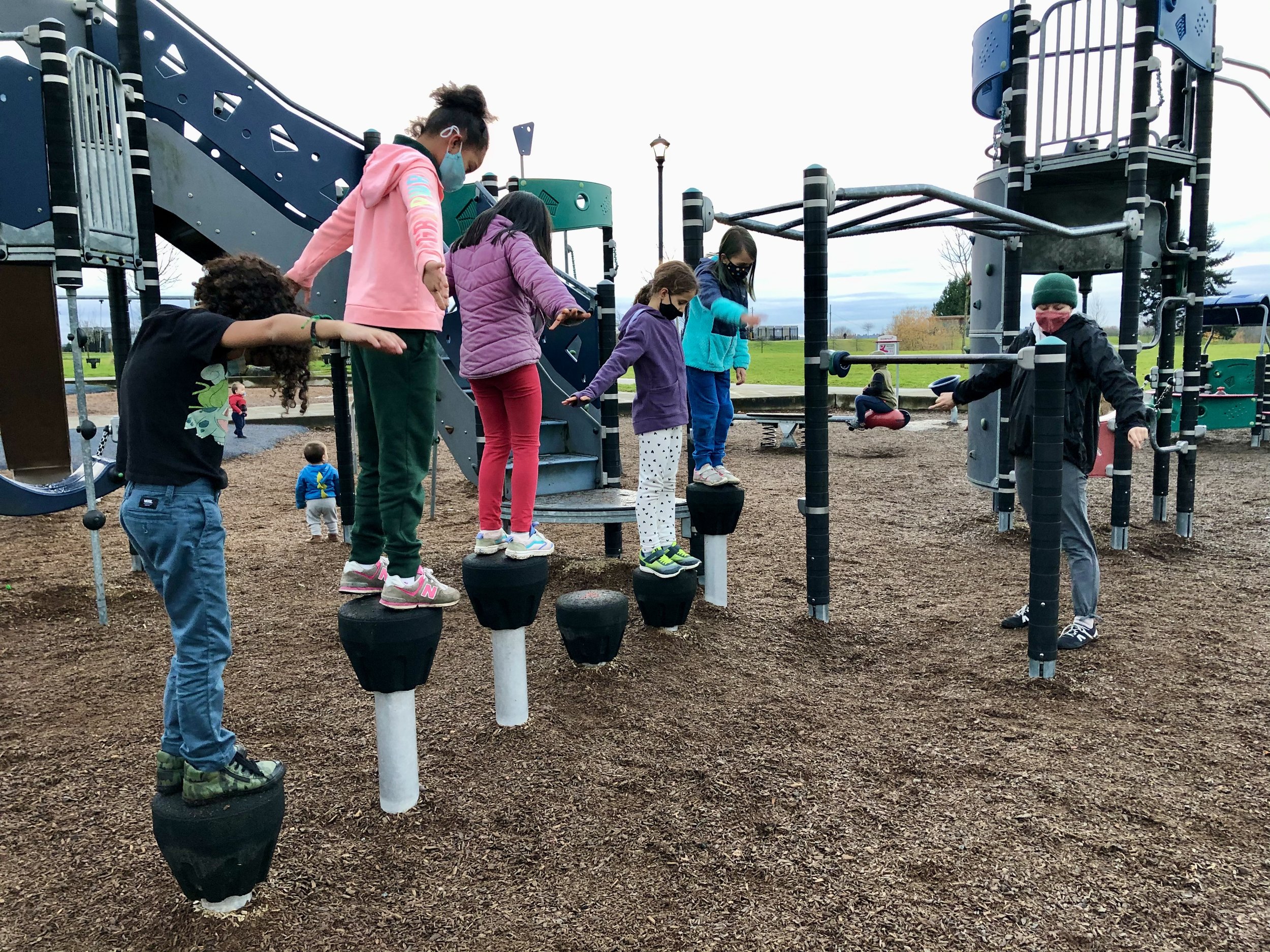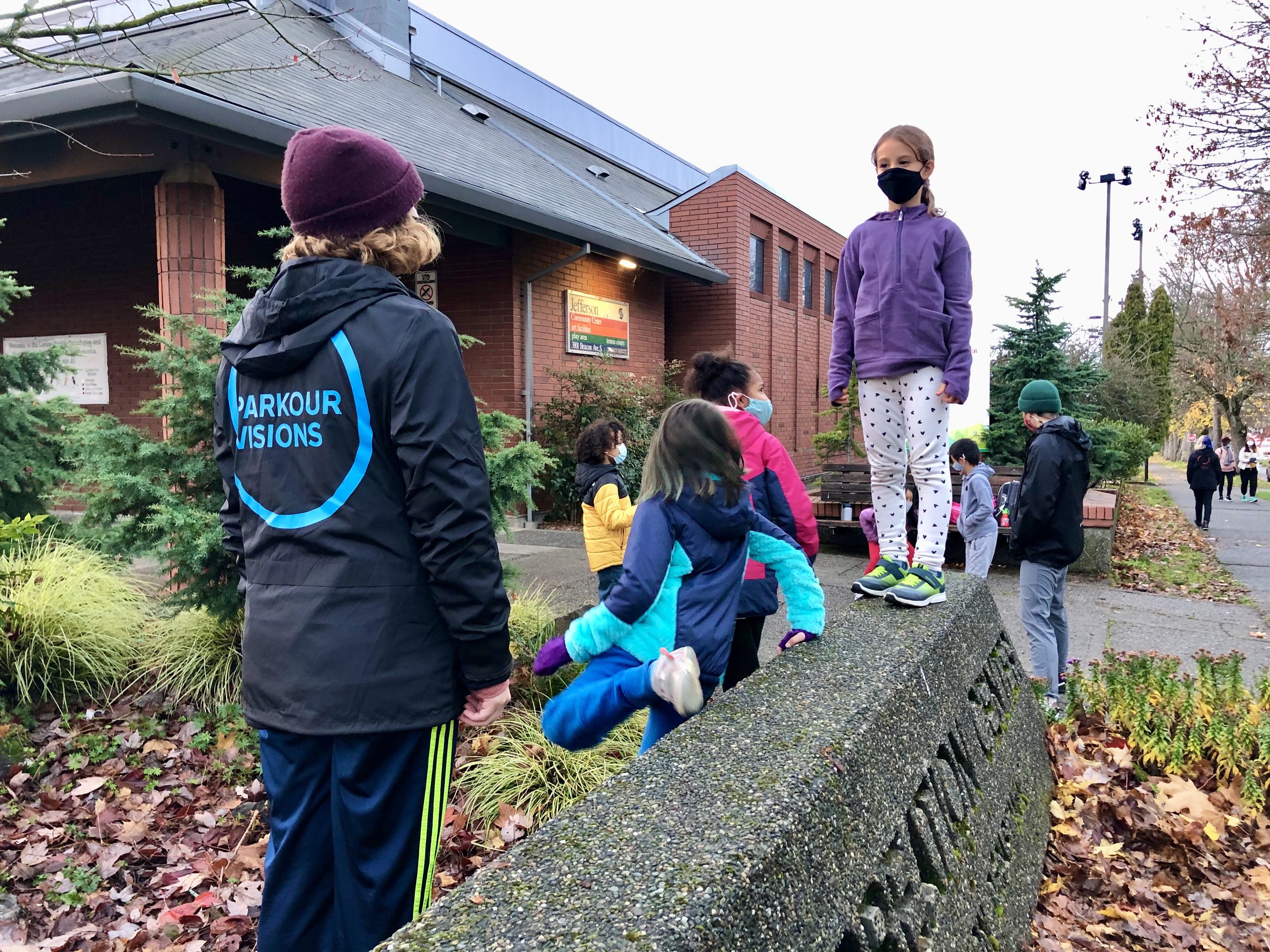Best Gear to Keep you Training Parkour All Winter
As winter approaches, you may be on the fence about continuing to do parkour outdoors. You look outside and think, “Gosh, it’s cold and getting dark early. Maybe I’ll skip this week.”
We get it. We coach parkour outdoors year-round. Even though we love the community, we wouldn’t be able to coach in the winter if we got cold and wet every time. So what are our coaches’ secrets to staying warm, dry, and comfy?
I asked our Portland and Seattle coaches about their favorite clothing and other gear for rain and winter. Their recommendations will help you gear up for cold and/or wet weather as we have in the Pacific Northwest. Here, it’s frequently rainy and wet, though we don’t get much snow. If your area has lots of snow or extreme cold, you’ll need to adapt accordingly.
Layering and Fabric Choice
The most important principle of winter training is layering. Layers give flexibility with their added warmth. Coach Jason says, “Leggings and layers have been the number one things to keep me training and warm.” You can see his video on rain training here.
How much you layer depends on how cold you feel outdoors that day. Women tend to run colder for myriad reasons, but this is not universally true. Whether you run hot or cold, layering gives you options.
For your upper body clothing, you can layer a short sleeve, long sleeve, sweater or sweatshirt, and coat or rain shell on top. Long-sleeve compression shirts like Under Armour are popular choices for our coaches. See below for our picks on fabric and rain gear.
Coach Harmony teaching a youth class. Everyone has different layering needs. One student may be in short sleeves while another is wearing a hat, gloves, and winter coat.
For your lower body, a pair of sweatpants may be enough on dry days. On wet days, cotton sweats can get waterlogged. As coach Caleb notes, “Pants with thin fabric hold less water.”
Coach Payton prefers leggings or compression pants: “Last winter, my kit was martial arts spats under water-resistant pants and it saved my life!” (If you’d like to shop at that link, you can use Payton’s discount code BLINDPARKOUR for 15% off.) For the coldest days, I like leggings under sweatpants so that the sweats can be removed if I get too hot.
For fabric choice, wool is the most popular choice amongst our coaches. The more likely you are to get wet, the more useful wool becomes.
As we wrote in Rain Training in Parkour: How and Why, “Avoid cotton [for wet weather]. It holds a lot of water, weighs you down, and sticks to your body. Synthetic fabrics tend to repel water better than cotton. Wool sheds water and retains its insulating properties, even when wet.”
Wool can be expensive. If you can only choose one piece, wool socks are the most indispensable for our coaches. Coach Lex in particular is a “huge advocate of wool socks and layering sweaters with rain jackets.”
Shoes and Socks
Next most important is your choice of shoes and socks. If you choose poorly, you could end up either overheated in boots, or miserable with cold, wet feet.
Rebecca wearing Vessi waterproof sneakers to train at Irving Park.
Here, our coaches are split between three different strategies:
Wear whatever you normally wear. Get wet and don’t worry about it! This may work best if you run very warm and/or train very hard.
Normal shoes plus upgraded socks. Waterproof socks are an ideal choice (note, they’ll need to be hand washed and air dried to retain their waterproof properties). Wool socks will also keep you warmer than cotton, and usually do not need special washing/drying.
Rain- or winter-specific footwear. For cold feet, waterproof footwear is the only bulletproof strategy for keeping you warm and dry. I personally wear Vessi waterproof sneakers, which have excellent grip in wet weather. They also come in kids’ sizes, although they run large for both youth and adults. For snowy or especially cold days, snow boots may be an appropriate choice (e.g. minimalist Xero boots). Parkour Generations Boston suggests shoe covers. Kids can sometimes get away with wearing rain boots. As a child progress, they will want more reliable footwear for the winter.
Will your normal shoes work in wet conditions?
“Experiment to find shoes that grip on wet surfaces. Rubber may work, but water changes things on every surface,” says coach Caleb. It’s not unusual for parkour practitioners to have different shoes for different conditions. Even so, in our classes, we always test surfaces and use extra caution when it’s wet.
Rain Gear
Coach Catlyn wearing a Parkour Visions rain jacket.
A rain shell over your clothing adds versatility to your training. It both sheds water and acts as a wind-breaker on cold, dry days. Some of our coaches also wear rain pants when they are going to be outside for hours at a time. On the downside, rain gear can hold in too much heat, so some of our coaches prefer not to wear it.
Rain gear doesn’t need to be fancy to do its job. Coach Niko prefers to buy rain jackets and pants from Costco. If you’re going to be rolling on the ground, you may not wish to spend a lot of money on your rain gear.
If you want to invest more, coach Caleb suggests Gore-Tex or a similar breathable, waterproof fabric. You’ll want to keep your rain gear in good condition, as the water-repellant coating can wear off with use. You may be able to restore your jacket’s performance by washing and reapplying a spray-on product.
Optional features we like include zippered pockets, big hoods with ties or elastic adjustments, vents, wrist closures, and a drawcord at the bottom hem. Read this article from REI for an in-depth discussion of rain jacket materials and features.
Gloves and Hand Warmers
For hand warmth, strategies vary significantly, from mittens and gardening gloves to gloveless in all but extreme cold. What kind of gloves you wear depends on your skin temperature and what you want to do with your hands. If you’re only jumping, you can wear any kind of glove or mitten you like. If you want to touch surfaces, you’ll need higher-performing gloves.
For safety, make sure your gloves or mittens are grippy and fit tightly. Loose-fitting or 100% fabric gloves can increase the risk of your hands slipping. Pay close attention to how your hands work within your gloves. Adjust your movement to make sure you stay safe.
Here are the most common strategies for keeping your hands warm for training in cold weather:
No gloves, because your hands run hot. Lucky you!
Training harder or shortening training. If your hands run cold but you really don’t want to wear gloves, you can alter your training.
Occasional gloves use. You may only need them until you warm up. You might only want them for quadrupedal, when your hands are on the ground.
Gardening gloves. We’ve seen an increasing number of adult students show up wearing gardening gloves. They provide good grip, plus some level of protection from the wet and cold.
Waterproof gloves. A lightweight, waterproof glove is a great choice for cold, wet days when you want to train as normally as possible.
Mittens. “If it’s a really cold day, I’m not above mittens,” says coach Cory. Maybe you’re not climbing walls in mittens, but at least you get to play outside!
Hand warmers. If you’d prefer to train glove-free but don’t want to suffer from freezing hands, keep a pair of hand warmers in your pockets! PKV coaches get these rechargeable hand warmers as part of our gear.
A selection of the author’s gloves for various uses. From left: Gardening gloves, wool mittens, fleece gloves, waterproof gloves, and PKV-issued rechargeable hand warmers.
Hats and Scarves
When it comes to hats, pretty much any beanie will do. Ideally, your hat stays firmly on your head while jumping and rolling. But if it falls off, you can always put it back on. Coach Cory likes a thick, brimmed beanie like this one. “Mine has rubber on the inside so it stays on my head even if I’m upside down.”
Scarves and gaiters are useful if your neck gets cold. Plus you can easily remove them when you warm up.
Bonus Gear
For optimal rain and winter training, our coaches have a few final top-secret gear tips:
Spare clothes, socks, and shoes to change into after training. You may be willing to get wet while you’re jumping around, but you don’t have to shiver on your way home.
Waterproof bag. Keep your first aid kit, towel, and spare clothes dry with a waterproof bag (like for watersports).
A towel is great for drying off wet rails or other inconveniently wet surfaces.
Hot drink in a thermos. Sometimes it’s the little things that make the difference.
If you have a pro tip that we missed, you can email me at rebecca@parkourvisions.org, and we may add it to our list.
Further reading:
About the Author
Rebecca Brightly writes stories about fitness and culture. Rebecca discovered parkour (“advanced urban navigation”) in 2017, after 10 years of partner dancing and teaching. Parkour has been a safe space to explore creativity, gender fluidity, discipline, and connection. @rebeccabrightly




